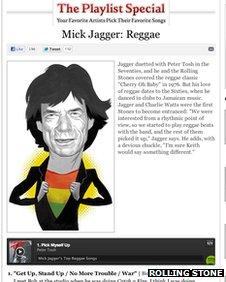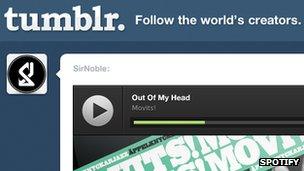Spotify web buttons aim to extend music service's reach
- Published

Rolling Stone magazine is among those signing up to Spotify's buttons
Spotify is seeking to extend its reach with the launch of a "play button" that can be embedded into third-party websites.
The music streaming service says the move will make it easier for bloggers and web editors to add songs without the threat of "legal takedowns".
Users must have signed up to the firm's service to activate the links.
Time Out, the Huffington Post, Vogue and the blogging service Tumblr have all committed to using the widget.
"We believe that the web is very fragmented when it comes to adding music," Spotify's chief product officer Gustav Soderstrom told the BBC.
"We want to enable people to be able to add music and soundtracks to their websites without having to distract the user with videos, banners and pop-ups. Previously it's just been short samples, or the audio quality has been poor.
"We think if we can allow the music to be integrated seamlessly then people will be more engaged with the sites and will stay longer absorbing the rest of their content."
Widget editor
The music's data is not embedded into the sites. Instead, clicking on one of the buttons triggers the launch of Spotify's player application. If the user is not a paying subscriber, this might trigger an advert and contribute towards their 10 hours per month listening limit in territories where this applies.
Spotify previously offered web links that covered a similar function, but clicking on them took the user away from the site they had been looking at.
Web editors can create the buttons, determining their size and look, using a widget editor on Spotify's developers site that "takes under a minute to use".

Spotify is likely to gain increased exposure through its tie-up with blogging service Tumblr
Tumblr is also integrating the service into its dashboard, allowing buttons to be created within its site.
'Speed bump'
Mark Mulligan, editor of the Music Industry blog, said the move will pose challenges to some of Spotify's competitors.
"I'd be worried if I were Soundcloud - the audio-sharing service has become the standard for audio embeds in websites and has been pushing hard to extend its reach," he said.
"It should be less of a concern for YouTube which has the advantage of videos.
"Spotify's number one reason to do this is to extend its subscriber numbers, but there are risks for some of its initial partners. GQ, Vogue and the Guardian all attract a broad demographic of readers, only a small subset of which will be Spotify members. So there could be a 'speed bump' if many of their audience are unable to listen to the buttons placed on their sites."
- Published13 March 2012
- Published30 November 2011
- Published8 March 2012
- Published25 March 2011